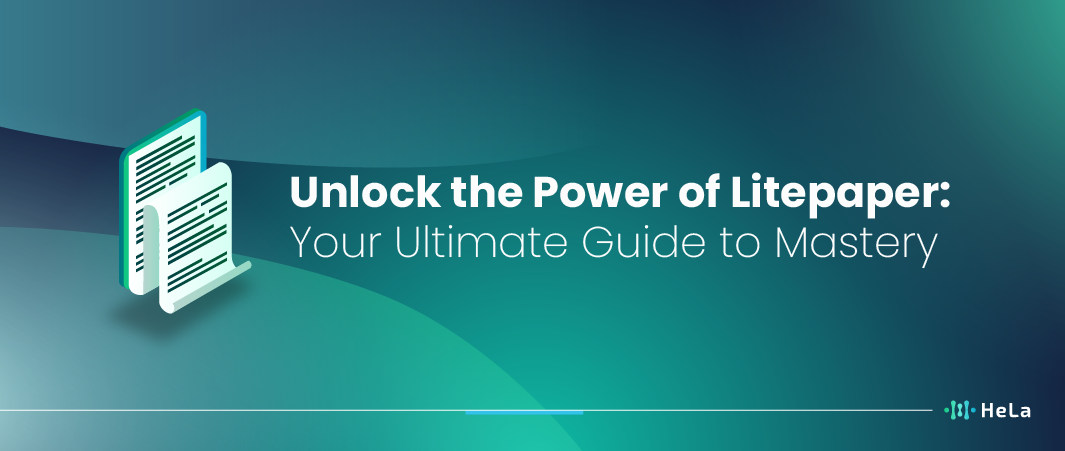In the vast realm of content creation, the term ‘litepaper’ has emerged as a buzzword, capturing the attention of writers, businesses, and readers alike. But what exactly is a litepaper? How does it differ from the traditional whitepaper, and why has it become so popular? This guide aims to demystify the concept of litepapers and provide a step-by-step approach to writing and formatting one effectively.
Litepapers, in essence, are a condensed version of the more detailed whitepapers. They present information in a more digestible format, making it easier for readers to grasp complex topics quickly. As the digital age demands faster and more concise content, litepapers have become the go-to solution for many. Let’s delve deeper into the world of litepapers and understand how to create one.
What is Litepaper?

A litepaper is like the CliffsNotes version of a traditional whitepaper. While whitepapers can be long and full of detailed research and data, litepapers are a more reader-friendly and concise alternative.
They aim to give you the key information in a straightforward way, without drowning you in a sea of details. Think of it as the “greatest hits” of a whitepaper, providing the most important insights without overwhelming you with too much information.
Also Read: What is a Layer 1 Chain?
In essence, a litepaper is all about simplifying complex topics. It’s designed to make things easy to understand and digest, so you don’t have to wade through pages and pages of dense material.
Whether you’re a busy professional looking for a quick overview or just someone who prefers a more straightforward approach to learning, a litepaper is your go-to resource for getting the essential information without the information overload. So, if you want the highlights without the headache, give a litepaper a try.
The Evolution of Litepapers
Whitepapers have been a trusted source of comprehensive research and detailed insights for a long time. However, as the internet’s influence grew and people’s attention spans shortened, there arose a demand for a more concise format. That’s where litepapers come into play.
These documents preserve the core essence of a whitepaper but are thoughtfully crafted to be consumed in a fraction of the time. Litepapers strike a perfect balance between depth of information and brevity, catering to the demands of our fast-paced modern world.
Litepapers offer a solution for those seeking knowledge but without the luxury of time for extensive reading. They distill complex topics into easily digestible content, making them a valuable resource for individuals, businesses, and researchers. In a world where time is of the essence, litepapers empower readers to stay informed and gain a deeper understanding of subjects without the overwhelming commitment that traditional whitepapers often require.
Why Litepapers are Crucial in Today’s Content Landscape

Litepapers have emerged as crucial assets in today’s content landscape due to several factors that have reshaped the way information is consumed and shared. In this digital age, where attention spans are dwindling, and the volume of content is overwhelming, litepapers offer a strategic solution to engage audiences effectively and deliver valuable insights.
Here’s a deeper look at why litepapers have become indispensable:
1. Quick Consumption
In a fast-paced world where everyone’s racing against the clock, litepapers come to the rescue by giving folks the opportunity to grasp tricky subjects without the need for hours of reading. These concise documents are like your shortcut to knowledge, providing a way to get a handle on complex topics without slogging through endless pages.
They’re all about saving you time while still helping you understand the important stuff.
2. Engagement
Litepapers are designed to capture and maintain readers’ attention throughout their concise and reader-friendly format. These bite-sized documents aim to keep readers engaged right from the beginning until the very end.
By presenting information in a straightforward and easy-to-digest manner, litepapers ensure that readers stay interested and don’t get lost in jargon or lengthy explanations, making complex topics more accessible and engaging.
3. Versatility
Litepapers serve a multitude of purposes, whether it’s promoting products through marketing, facilitating learning in education, or simply sharing information with the wider audience. These concise documents are versatile tools that provide valuable insights and knowledge without overwhelming the reader.
They’re like the Swiss Army knives of communication, offering a user-friendly way to convey important information, ideas, or concepts. Whether you’re a marketer looking to promote a new product, an educator striving to simplify complex topics, or an enthusiast eager to share your insights, litepapers are your go-to companions in the world of effective communication.
Crafting the Perfect Litepaper: A Step-by-Step Guide

In this guide, we will explore the essential steps and best practices involved in crafting a compelling litepaper that effectively communicates your project’s vision and potential. The litepaper plays a critical role in the success of your project, as it serves as the first point of contact for many stakeholders. Whether you’re launching a new cryptocurrency, blockchain platform, or decentralized application, this guide will help you create a litepaper that captures attention, builds trust, and generates interest in your project. Here are some key areas we will cover in this step-by-step guide:
1. Identify Your Audience
Before you begin writing, it’s important to have a clear understanding of who you’re writing for. This will help you create content that resonates with them and meets their specific needs and preferences. Think about your audience’s interests, questions, and what they find engaging. By keeping your readers in mind, you can craft content that speaks directly to them, making it more relatable and valuable.
2. Choose a Relevant Topic
Choose a topic that genuinely connects with your audience and provides them with useful information or insights. Think about what matters to the people you’re trying to reach and find a way to address their needs or interests in a clear and relatable manner. By focusing on subjects that matter to your audience and delivering valuable content, you can build stronger connections and make a meaningful impact.
3. Research Thoroughly
While keeping things concise is important, it’s equally crucial not to sacrifice the depth and quality of your litepaper. Make sure that your litepaper is well-supported by thorough research and substantial information. Remember, brevity doesn’t mean skimping on substance; it means presenting your ideas clearly and concisely without losing the essence of your research and its foundational insights.
4. Write Concisely
A litepaper is all about keeping things simple and straightforward. It’s about being concise, crystal clear, and steering clear of any fancy or confusing language. In essence, it’s like explaining something to a friend in a way that’s easy to grasp and doesn’t leave them scratching their heads. So, when you’re working on a litepaper, think of it as a conversation with a buddy where you’re getting right to the point without any unnecessary fluff or complexity.
5. Use Visuals
Using infographics, charts, and images can make information more engaging and easier to grasp, preventing the boredom that can come from reading plain text. These visual aids not only break up the monotony but also provide a visual representation of data or concepts, making complex information more accessible. Whether it’s a colorful chart illustrating trends or a well-designed infographic summarizing key points, visuals have the power to enhance comprehension and keep readers or viewers more interested and informed.
Formatting Tips for an Engaging Litepaper

Creating an engaging litepaper is essential for effectively communicating your project or idea to a wider audience, especially in the world of cryptocurrencies and blockchain technology. A litepaper is typically a shorter and more concise version of a whitepaper, serving as an introduction and overview of your project. To ensure your litepaper is both informative and captivating, consider the following formatting tips:
1. Use Headers and Subheaders
Using headers and subheaders is a great way to organize your content effectively. It helps break down your text into smaller, more manageable sections, making it a breeze for readers to skim through and find what they’re looking for. Think of headers as signposts on a road trip; they provide clear direction and make the journey smoother.
Whether you’re writing an essay, a report, or even an email, employing headers and subheaders can simplify the reading experience and ensure your message gets across clearly. So, don’t hesitate to sprinkle them throughout your content to guide your audience and keep them engaged!
2. Bullet Points and Lists
Bullet points and lists are handy tools that assist in conveying information in a clear and organized way. They provide a structured format for presenting data, making it easier for readers to grasp key points at a glance. By breaking down complex information into concise, easily digestible items, bullet points and lists enhance communication and improve comprehension.
Whether you’re outlining important details, summarizing key takeaways, or highlighting essential facts, these straightforward tools help you present information in a manner that is straightforward and accessible to your audience, promoting effective communication and understanding.
3. Consistent Font and Size
Ensure that the font style and text size remain consistent throughout your document to give it a polished and professional appearance. Consistency in these elements helps create a cohesive and visually pleasing document. When you maintain the same font and size, it’s easier for readers to follow along and understand your content without distraction. This simple step can go a long way in making your work look clean and well-organized.
Also Read: What is Layer 1? Definition and How does it work
4. Interactive Elements
To make your litepaper more interactive and engaging, you can include elements like hyperlinks, clickable buttons, or even QR codes. These features give your readers the ability to easily access additional information or take specific actions, making the litepaper more user-friendly and interactive. Hyperlinks can lead readers to related articles or external resources, clickable buttons can provide options like downloading a PDF or subscribing to updates, while QR codes can swiftly link to websites or apps for more interactive experiences. These simple additions can enhance your litepaper’s appeal and make it more user-friendly.
Conclusion
Litepapers have carved a niche for themselves in the content landscape, bridging the gap between detailed research and quick consumption. They are a testament to the evolving needs of readers and the adaptability of content creators. As we move forward, the importance of litepapers will only grow, making it imperative for writers and businesses to master the art of crafting them.
For those looking to dive into the world of litepapers, remember that while they demand brevity, they should never compromise on quality. With the right balance of research, writing, and formatting, you can create a litepaper that not only informs but also engages and captivates your audience. Happy writing!
Disclaimer: The information provided by HeLa Labs in this article is intended for general informational purposes and does not reflect the company’s opinion. It is not intended as investment advice or recommendations. Readers are strongly advised to conduct their own thorough research and consult with a qualified financial advisor before making any financial decisions.

Joshua Soriano
I am Joshua Soriano, a passionate writer and devoted layer 1 and crypto enthusiast. Armed with a profound grasp of cryptocurrencies, blockchain technology, and layer 1 solutions, I've carved a niche for myself in the crypto community.
- Joshua Soriano#molongui-disabled-link
- Joshua Soriano#molongui-disabled-link
- Joshua Soriano#molongui-disabled-link
- Joshua Soriano#molongui-disabled-link

